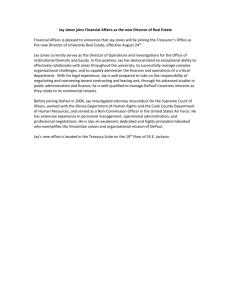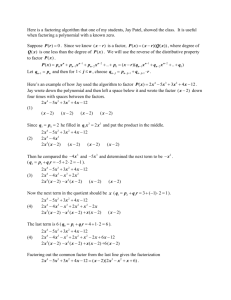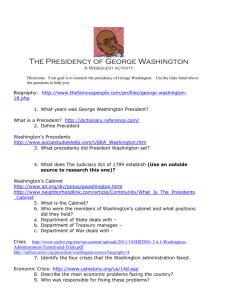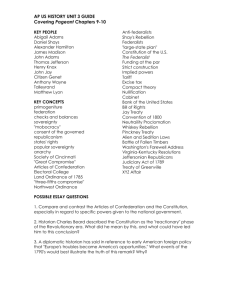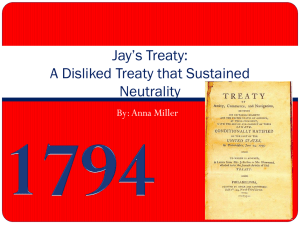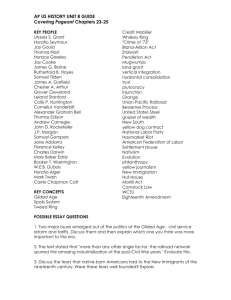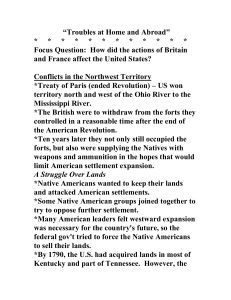John Jay and the Treaty of Paris
advertisement
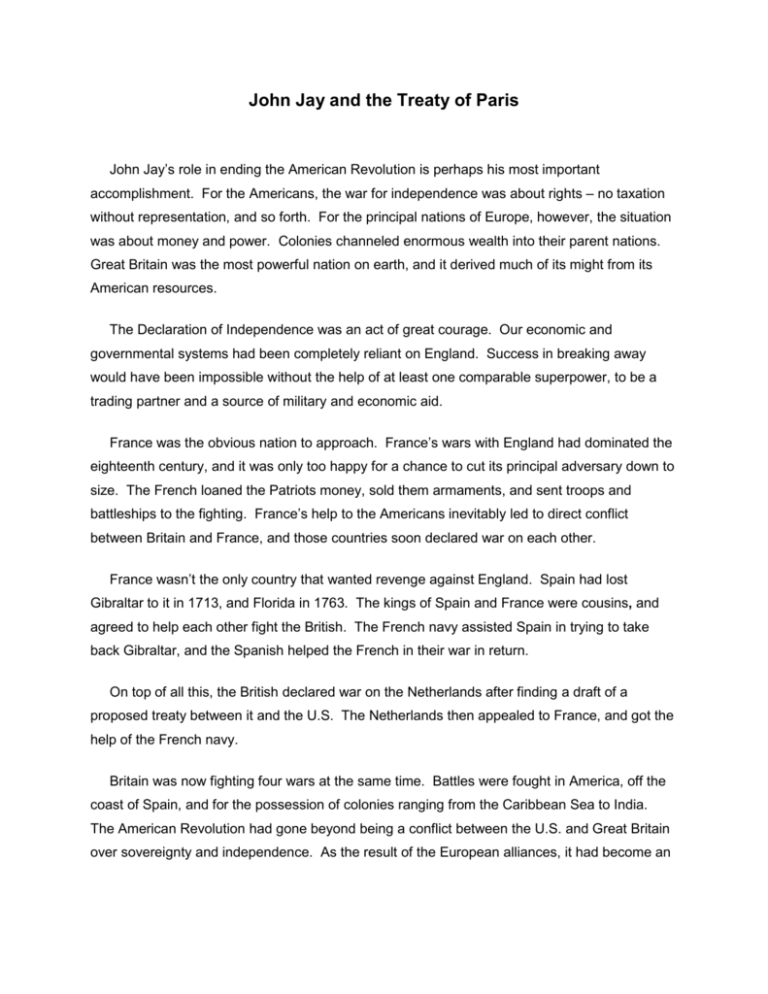
John Jay and the Treaty of Paris John Jay’s role in ending the American Revolution is perhaps his most important accomplishment. For the Americans, the war for independence was about rights – no taxation without representation, and so forth. For the principal nations of Europe, however, the situation was about money and power. Colonies channeled enormous wealth into their parent nations. Great Britain was the most powerful nation on earth, and it derived much of its might from its American resources. The Declaration of Independence was an act of great courage. Our economic and governmental systems had been completely reliant on England. Success in breaking away would have been impossible without the help of at least one comparable superpower, to be a trading partner and a source of military and economic aid. France was the obvious nation to approach. France’s wars with England had dominated the eighteenth century, and it was only too happy for a chance to cut its principal adversary down to size. The French loaned the Patriots money, sold them armaments, and sent troops and battleships to the fighting. France’s help to the Americans inevitably led to direct conflict between Britain and France, and those countries soon declared war on each other. France wasn’t the only country that wanted revenge against England. Spain had lost Gibraltar to it in 1713, and Florida in 1763. The kings of Spain and France were cousins, and agreed to help each other fight the British. The French navy assisted Spain in trying to take back Gibraltar, and the Spanish helped the French in their war in return. On top of all this, the British declared war on the Netherlands after finding a draft of a proposed treaty between it and the U.S. The Netherlands then appealed to France, and got the help of the French navy. Britain was now fighting four wars at the same time. Battles were fought in America, off the coast of Spain, and for the possession of colonies ranging from the Caribbean Sea to India. The American Revolution had gone beyond being a conflict between the U.S. and Great Britain over sovereignty and independence. As the result of the European alliances, it had become an impetus for a complex series of wars, fought for the purpose of weakening Britain and changing the balance of power in Europe. With the British military spread out all around the world, the Americans began to succeed. In October 1781, Washington defeated Cornwallis at Yorktown, bottling up seven thousand redcoats with a combined force of Continental soldiers, French soldiers, and French warships. The loss convinced the British it was time to discuss peace with the Americans, rather than press on for a victory that their other wars had rendered unlikely. Their goal was a peace that would keep America within the British Empire. Even before Yorktown, Congress started preparing for peace talks. It appointed a diplomatic team consisting of John Adams, Benjamin Franklin, John Jay, Thomas Jefferson, and Henry Laurens. Under heavy influence from the King of France’s representative in Philadelphia, Congress gave the following order to their peace commissioners: they were told to “make the most candid and confidential communications upon all subjects to the ministers of our generous ally, the King of France; to undertake nothing in the negotiations for peace or truce without their knowledge and concurrence; and ultimately to govern yourselves by their advice and opinion.” In other words, Congress ordered that the future of the U.S. be handed over almost entirely to King Louis XVI and his ministers. It is no surprise that Paris was chosen to be the place where peace talks would be held. Of the five commissioners, Thomas Jefferson was unable to travel to Europe, and never participated in the talks. Henry Laurens had been captured by the British, and was imprisoned in the Tower of London. John Adams was in Amsterdam, negotiating a Dutch loan to the U.S. But Benjamin Franklin was in Paris already, where he had been U.S. Minister to the Court since 1776. John Jay was in Spain. He had spent two and a half frustrating years trying to obtain Spanish aid for America, with practically no success. The Spanish were loathe to support any colonial rebellion: that would have given their own colonists ideas. In April 1782, Franklin wrote Jay, “Render yourself here as soon as possible.” Jay was more than happy to go. Franklin had been highly successful in his work with the French foreign ministry, getting millions in foreign aid for the U.S. And he developed a cordial relationship with the Count of Vergennes, Louis XVI’s Foreign Minister. Jay arrived in Paris in late June, and Franklin took him on a series of visits to meet the diplomatic community. On the day he met Vergennes, Jay is believed to have worn a suit which is now in John Jay Homestead’s historic collection. Its color is very faded: when new it was a light pastel green – not Jay’s taste at all, but appropriate for appearances at the French court. The British peace commissioner in Paris, Richard Oswald, received his official commission in early August. Oswald’s commission authorized him to negotiate with the representatives of the “colonies or plantations” at war with Britain in America. Jay discovered that the commission directed Oswald “to treat with the colonies, and with any or either of them, and any part of them, and with any description of men in them, and with any person whatsoever.” In other words, Oswald’s commission did not recognize the United States, but approached it as a group of colonial lands that could be split for treaty purposes into political units with no connection to each other. That would have put a swift end to the United States as it had defined itself in the Declaration of Independence. Jay was outraged. Beyond Britain’s obvious disrespect for America, Jay knew that to get decent terms in the final treaty, America would have to be negotiated with, not as a unrelated collection of subordinate territories, but as a bona fide nation in its own right. Jay and Franklin also met with representatives of the Spanish foreign ministry. Spain owned the Louisiana Territory at the time. Louisiana’s eastern border was the Mississippi River, which the U.S. wanted recognized as its western border. Spain did not want to see a strong, independent U.S. develop in the Americas, and moreover, it wanted complete control of the Mississippi, which was the gateway to the North American interior. Spain’s ambassador to France met with Jay and Franklin, and proposed a western border for the U.S. five hundred miles east of the Mississippi. Afterward, Jay and Franklin met with Vergennes to report on their talks. They learned that the French supported the Spanish proposal to confine the U.S. to a comparatively narrow strip of land along the east coast. What was more, they did not support Jay’s insistence that Britain recognize U.S. independence as a precondition for peace talks. That evening, Franklin and Jay talked over what to do next. Jay argued that Congress’s order to obey the French was in direct conflict with American interests, and should be disregarded. Franklin expressed his unease with offending the French and risking the loss of their help in the war with Britain. According to an oral tradition, Jay lost his temper and smashed his pipe into a fireplace in a fit of anger. In late August, Franklin became incapacitated for over a month with health problems. That left John Jay the sole active American peace commissioner. In Britain, the Prime Minister was under increasing pressure. Some Britons favored pressing on for victory over the American rebels. Others wanted to arrange some sort of peaceful accommodation with them. Almost nobody wanted to see them become independent, least of all, the King. Both Parliament and the British Cabinet were divided within themselves on the right course of action. Prime Minister Shelburne wanted the American war to end so he could concentrate his resources on Britain’s other three wars. Jay’s insistence on an official acknowledgment of U.S. independence before talks could begin was road-blocked by the opposition in England. Things were at an impasse. Then, on September 9th, Jay learned that Vergennes had sent his deputy on a mission to England. Jay immediately feared the worst: that Britain and France were moving toward forging a peace between themselves, whose terms would be harmful to America. The expense of supporting four wars against Britain was draining France’s treasury, and Vergennes was looking for a way out. Jay spoke with Franklin about the French mission to England, and learned that Franklin wasn’t especially concerned about it. Jay then made the boldest move of his life: he disobeyed the Congressional order to obey and inform the French. Jay convinced Benjamin Vaughan, an associate of Richard Oswald who was also a friend of the Prime Minister, to travel to Britain from Paris. Vaughan agreed to relate the American positions on several treaty issues to Shelburne, in order to counter any French proposals. And, he carried with him a redrafted commission for Oswald, written by John Jay. The mission was done in strict secrecy from the French. Jay even kept it secret from Franklin. Jay decided he could not take the chance that Franklin might reveal Vaughan’s mission to Vergennes, and tip the scales in France’s favor over America’s. The French deputy foreign minister met with Prime Minister Shelburne first. He made France’s case, exactly as Jay had suspected, for a peace between the two superpowers. He argued in favor of Britain’s denying America fishing rights off the coast of Canada, and giving them instead to France. He also offered French help to the British in opposing American claims to the land between the Appalachian Mountains and the Mississippi River. The meeting could not have made clearer to Shelburne that France’s alliance with America was fracturing. Vaughan arrived at Shelburne’s next. He related the American case on the treaty issues between Britain and America. He also presented Jay’s draft of a new commission for Richard Oswald. It was worded to authorize Oswald to negotiate with representatives of “the Thirteen United States of America.” The British Cabinet discussed the redrafted commission, and adopted a modified version of it, keeping Jay’s use of the name “United States of America.” This was the critical breakthrough: for the first time, the British government issued an official document that addressed the U.S. not as a group of subordinate lands, but as it would a separate country. The impasse had begun to break. Jay had struck the first crack in the wall of official British resistance to American independence. Vaughan arrived back in Paris with Oswald’s new commission, and an assurance that Shelburne wanted peace. Franklin quickly forgave Jay for going around him. He was still uncomfortable about keeping their dealings from the French, but he went along. Now that Britain had acknowledged a more fitting stature for America, real talks could begin. Jay wrote the first draft of the Preliminary Articles of Peace singlehandedly. Oswald submitted Jay’s draft, with minor modification, to London. Then, on October 26th, John Adams arrived in Paris to join Jay and Franklin, who had recovered enough to participate in the talks. Jay briefed Adams on where things were, and Adams discovered that on nearly every point, Jay’s opinions were the same as his. When the two next met with Franklin, Adams forcefully told Franklin how he agreed with Jay’s “whole conduct” in the course he had taken with the British and the French. Franklin sat and listened quietly. Before their next meeting with the British, he surprised his colleagues by telling them he would cooperate with them fully in keeping news of their progress from the French. Franklin understood the importance of presenting a united front, and worked in complete solidarity with Jay and Adams from that point on. In mid-November, the Prime Minister convinced the British Cabinet to have the upcoming session of Parliament postponed for nine days. He knew that any agreement that recognized American independence would not get enough votes to pass. Under British law, if Parliament was not in session, the Prime Minister could act unilaterally. If Shelburne could get an agreement signed with the Americans before Parliament went back into session, one of Britain’s four burdensome wars could be brought to an end. Jay, Adams, and Franklin all saw immediately their opportunity. Shelburne’s back was to the wall. In order to settle in a few days, they could press for British concessions they might not otherwise be able to get. They fought tenaciously on big points, and compromised on smaller ones. Finally, in late November, the preliminaries were finished. Besides an end to the fighting, America got Britain’s agreement to its total independence from the British Empire. It won westward expansion to the Mississippi, access to the fisheries near Newfoundland, and very favorable trade terms. What Britain got out of the agreement was an earlier end to the war in America, and, very important to Shelburne, it got to hold onto its American trade. The French had counted on the Americans ceasing their trade with Great Britain after the war, and diverting all that cash flow to France. That didn’t happen. Britain would continue to profit from its former colonies, even if it no longer owned them. The Preliminary Articles of Peace were signed on November 30th in Oswald’s quarters in Paris. A painting, also from our collection, illustrates the signing. The right side is blank because the British Peace Commissioner and his secretary refused to pose for it. Franklin, aware that Vergennes could now not prevent the signing of the agreement, sent him a copy the night before, to maintain the appearance of fulfilling his official duties. Upon reading the agreement, Vergennes was not pleased. The Americans had won their way on every major point, an astounding achievement given the difference in sheer might between Great Britain and the United States. Since the agreement was worked out after John Adams’ arrival in Paris, many of the French attributed its success to him. Adams enjoyed the attention, but was too wise not to recognize two of the most critical factors in achieving its success: getting out from under the control of the French foreign ministry and breaking the British impasse on independence. Had the Americans negotiated as puppets of the French or as colonial British subjects, they could never have gotten the terms they did. Adams saw clearly who had won them the diplomatic self-determination that had made their triumph possible. At the end of the day the Preliminary Articles were signed, he wrote in his diary, that the French, had they known the full story of the talks, “would very justly give the title with which they have inconsiderately decorated me, that of Le Washington de la Négotiation, a very flattering Compliment indeed, to which I have not a right, but sincerely think it belongs to Mr. Jay.” The preliminaries had now been signed, but the final treaty was still months away. Three other wars were still on. On account of America’s alliance with France, it could not sign a final treaty with Britain until France was ready to, and on account of the alliance between France and Spain, France could not sign a final treaty until Spain was ready to. It was not until September 1783 that the Treaty of Paris could be finalized. The three European wars ended in a draw. Some colonial territories were kept by their parent nations, and others were exchanged. In England, Shelburne was censured in the House of Commons, and resigned as Prime Minister. A new government was formed, Oswald was recalled, and David Hartley was sent to Paris to take his place. For four months, Hartley worked with the Americans on refinements to the final treaty. But the British government ultimately decided to keep to the terms of the Preliminaries signed the previous November. In order to avoid another rancorous debate in Parliament, they decided to keep to the earlier agreement. The signing of the definitive peace treaty between Britain and its adversaries took place September 3rd. While the signing of the treaties between Britain, Spain, and France was to be held at Versailles, David Hartley’s commission required that he sign with the Americans in Paris. So that morning, Adams, Franklin, and Jay came to Hartley’s rooms at the Hôtel d’York, and signed the treaty there. After the treaty between America and Britain was signed, everybody went to Versailles to watch the signing of the agreements between England, France, and Spain. Ratifications of the treaty by Parliament and Congress were exchanged by Jay and Franklin and Hartley in Paris on May 12, 1784. The American diplomatic team remained in touch with each other after their great work was completed. In a letter to Franklin, Jay looked back and recalled, “We worked in strange but successful concert. We had in common, I think, good will and good sense. And between the three of us who did the most work—yourself, myself, and Mr. Adams—we combined to one efficient device serving well the interest of our countryman and, I would hope, mankind. Pride is of course a sign, but methinks I shall nevertheless be proud of my role here for some time to come.”

